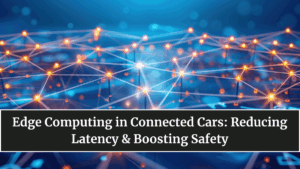The automotive industry is becoming increasingly digital — and at the heart of this transformation lies edge computing. In 2025, cars are no longer just vehicles; they are moving data centers, processing billions of inputs every second. Edge computing enables this by bringing computation power directly inside the vehicle, ensuring faster, safer, and smarter decision-making without always depending on cloud connectivity.
As cars become more autonomous, connected, and AI-driven, data latency can be the difference between safety and disaster. Edge computing minimizes this delay by allowing cars to analyze information locally — from sensors, cameras, and radars — in real time.

What Is Edge Computing in Cars?
In simple terms, edge computing means processing data closer to where it’s generated rather than sending it all the way to a central server or cloud. In the case of vehicles, this means the data collected by onboard systems is processed within the car itself, through powerful embedded processors.
Key functions include:
-
Detecting obstacles and pedestrians in milliseconds.
-
Making split-second driving decisions in autonomous systems.
-
Managing infotainment, navigation, and connectivity simultaneously.
-
Communicating with surrounding infrastructure like traffic lights and other vehicles.
By processing data on the edge — i.e., directly in the car — latency drops dramatically, improving safety, reliability, and user experience.
Why Edge Computing Matters for Modern Cars
Today’s connected cars generate over 25 GB of data per hour, coming from dozens of sensors, cameras, and GPS modules. Sending all this data to the cloud would cause massive delays and bandwidth issues. Edge computing solves this by distributing intelligence between the car and the cloud, allowing critical decisions to be made instantly, while non-urgent updates are synced later.
This approach is especially vital for autonomous vehicles, where even a 100-millisecond delay could lead to an accident. Edge systems ensure that emergency braking, lane detection, and collision avoidance occur instantly, without waiting for external signals.
Core Technologies Powering Edge Computing
The rise of automotive edge computing is made possible by several interconnected technologies:
-
AI Chips & Neural Processors: Specialized processors handle real-time image and sensor recognition tasks.
-
5G Connectivity: Enables high-speed communication for non-critical cloud functions.
-
V2X (Vehicle-to-Everything) Systems: Allow vehicles to communicate with nearby cars, pedestrians, and infrastructure.
-
IoT Sensors & Telemetry: Collect continuous feedback from various parts of the vehicle.
-
Data Security Protocols: Protect user and system data from cyber threats.
Together, these systems form a distributed computing ecosystem — the vehicle becomes part of a smart city’s digital nervous system.
Real-World Applications of Edge Computing in Cars
The technology is already being deployed in several areas of the automotive ecosystem:
-
Autonomous Driving: Real-time object detection and path prediction rely on edge-based AI processing.
-
Predictive Maintenance: Edge analytics help detect early signs of component wear or sensor malfunction.
-
Driver Assistance: Instant responses for adaptive cruise control, lane departure, and parking assistance.
-
Infotainment Personalization: AI-powered voice assistants and real-time recommendations for drivers.
-
Fleet Management: Immediate communication of route changes, road hazards, or breakdown alerts.
Leading manufacturers like Tesla, Mercedes-Benz, and BMW are incorporating edge-AI modules that process terabytes of data on the go, ensuring seamless performance even in low-connectivity areas.
The Safety Advantage of Edge Computing
Safety remains the most important reason for integrating edge technology in vehicles. With edge computing, vehicles can react 10–50 times faster to potential dangers compared to cloud-only systems.
Key safety improvements include:
-
Instant Hazard Detection: Cameras and radar sensors can detect and respond to sudden obstacles.
-
Reduced Connectivity Dependency: Even if the internet connection drops, critical systems continue functioning.
-
Real-Time Navigation Updates: Edge-based mapping ensures accurate driving in tunnels or remote areas.
-
Enhanced Data Privacy: Sensitive driving data stays within the vehicle, reducing cybersecurity risks.
This combination of speed, resilience, and privacy makes edge computing the backbone of next-generation vehicle safety systems.
Challenges in Edge Integration
Despite its immense potential, edge computing comes with its own set of challenges:
-
Hardware Costs: Advanced processors and memory units increase production costs.
-
Thermal Management: High-performance chips generate heat that must be controlled safely.
-
Software Standardization: Different automakers use varied platforms, creating compatibility issues.
-
Data Synchronization: Balancing what stays local and what syncs to the cloud remains a technical hurdle.
However, with new innovations in chip design and open-source platforms, these barriers are gradually being overcome.
The Road Ahead: Smarter, Safer Mobility
As cars evolve into intelligent, networked entities, edge computing will become a non-negotiable standard for mobility. In the coming years, AI-driven vehicles will autonomously manage traffic flow, coordinate with other vehicles, and reduce accidents — all powered by edge intelligence.
Future trends include:
-
Decentralized Vehicle Networks that share real-time hazard data locally.
-
AI Co-Pilots offering predictive route planning and adaptive learning.
-
Energy-Efficient Edge Chips optimized for EVs and hybrid architectures.
-
Integration with Smart Cities, where traffic lights, roads, and vehicles all communicate seamlessly.
By merging edge computing with artificial intelligence and smart infrastructure, cities will move closer to a zero-accident, zero-congestion future — where your car doesn’t just drive you, it thinks with you.
FAQs
What is edge computing in cars?
It’s a technology that processes vehicle data locally instead of relying on cloud servers, enabling faster, real-time decisions.
How does edge computing improve safety?
By reducing latency, it ensures quicker reactions to hazards and keeps critical systems functional even without internet connectivity.
Which car brands are using edge computing?
Tesla, BMW, Mercedes-Benz, and Toyota are leading in integrating edge processors and AI chips for autonomous features.
Does edge computing replace cloud computing?
No. It complements the cloud — the edge handles real-time operations while the cloud manages updates and analytics.
What’s the future of edge computing in vehicles?
By 2030, nearly all connected and autonomous vehicles will depend on edge processing to ensure real-time safety, communication, and control.
Click here to know more.
